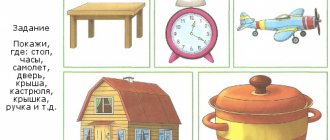A speech therapy examination should be based on general principles and methods of pedagogical examination: it should be complex, holistic and dynamic, but at the same time it should have its own specific content aimed at analyzing speech disorders.
Each speech disorder is characterized by its own set of symptoms, and some of them turn out to be the main primary symptoms for each disorder, the core ones, while others are only additional and only stemming from the main defect, i.e., secondary.
The methodology and techniques for conducting the survey must be subject to the specifics of its content.
The complexity, integrity and dynamism of the examination are ensured by the fact that all aspects of speech and all its components are examined, moreover, against the background of the entire personality of the subject, taking into account the data of his development - both general and speech - starting from an early age.
Speech therapy examination includes the following points:
1. First name, last name, age, nationality.
2. Complaints from parents, educators, teachers.
3. Early development data: a) general (briefly); b) speech (in detail, by period).
4. Brief description of the child at present.
5. Hearing.
6. Vision.
7. The child’s reaction to his speech difficulties.
8. Intelligence.
9. The structure of the organs of articulation, their mobility.
10. Speech: a) impressive; b) expressive - from the point of view of phonetics, vocabulary, grammatical structure; whether he speaks at length; c) written language - reading and writing.
11. Conclusion.
The first three points are filled out from the words of the mother, teacher, teacher accompanying the child, and based on the documentation provided. In cases where an adult applies, these sections are filled out according to the applicant’s words.
A brief description can be formulated from the words of the parents (educator, teacher), or can be presented by the child care institution sending the child. It is desirable that it contain information about what the child is interested in and how he reacts to his speech difficulties.
It is advisable to fill out the hearing and vision examination data on the basis of the submitted certificates from the otolaryngologist and ophthalmologist. If there are no specialists, then the speech therapist must check the hearing and vision himself and establish (by questioning) at what age the deviation from the norm was noted.
The state of intelligence is the main factor in the analysis of speech impairment. It is important to find out what comes first: a severe speech disorder that delays the overall development of the child, or mental retardation that delays and distorts speech development.
The speech therapist obtains data on the structure of the articulation organs based on an examination of the oral cavity. He establishes the mobility of the articulatory apparatus, inviting the child to make the basic movements of each of the organs (lips, tongue, soft palate), while noting the freedom and speed of movement, its smoothness and uniformity of movement of the right and left sides (tongue, lips, soft palate), and also the ease of transition from one movement to another.
First of all, the speech therapist must identify the level of development of the child’s intelligence and analyze his speech in detail. There are special techniques to clarify these issues.
The examination begins with a conversation. The topic for the conversation and the manuals that the speech therapist will use are considered and selected in advance, taking into account the age of the child.
During the conversation, the speech therapist tries to establish contact with the subject, and also reveals how the child understands his speech, whether he uses a phrase, and whether he pronounces sounds correctly. Establishing contact and the conversation itself help the speech therapist get an idea of the general mental and speech development of the child, and some of the characteristics of his personality.
Another methodological method of the examination will be the active observation of the speech therapist over the child in the process of his activities, which is organized by the speech therapist, offering him various materials (toys, pictures) and setting him various tasks of the game and educational plan. Tasks related to the processes of abstraction and generalization are of great importance.
A full understanding of speech is a necessary prerequisite for the correct use of speech and for further successful learning. Therefore, when starting to examine a child, the speech therapist studies all aspects of speech: its impressive and expressive sides.
When examining the impressive side of speech (speech understanding), the speech therapist focuses on how the child understands:
a) names of various everyday objects; b) generalizing words (clothing, dishes, furniture, fruits, vegetables, transport, etc.; c) a phrase of an everyday nature; d) a short text told or read to him. When examining speech understanding, you should not require a verbal response from the child. It is enough to receive it with the help of a gesture, selection of the necessary pictures, facial expressions, and individual exclamations.
When examining the expressive side of speech, the speech therapist studies: a) vocabulary; b) grammatical structure; c) sound pronunciation; d) voice, its tempo and smoothness.
Analyzing the children's answers, the speech therapist pays attention to the pace of speech (too fast or too slow, monotony or expressiveness of speech), smoothness or its disruption by more or less frequent and severe hesitations - stuttering. When stuttering, auxiliary movements of the arms, legs, and head may be noted.
To examine sound pronunciation, the speech therapist selects subject pictures so that their names include the sounds being tested at the beginning, middle and end of words. If the child incorrectly pronounces a sound in a word, the speech therapist suggests pronouncing this word with this sound by imitation, and then forward and backward syllables with this sound. The nature of the incorrect pronunciation of the sound is noted: the sound is omitted, replaced by another constantly or only in some words, distorted. If a child can pronounce both sounds in isolation, but still confuses them, you should check whether he distinguishes them by ear.
To do this, you can do the following types of work: a) repeat after the speech therapist combinations of sounds like ta-da and da-ta; b) correctly name the pictures (house, volume); c) correctly indicate one of the pictures named by the speech therapist, the names of which differ only in the sounds they mix (for example, bear - bowl or rat - roof, etc.) It is completely possible to check the discrimination of similar sounds if the child knows the letters and can write under dictation of syllables, words, phrases with the indicated sounds, since oral speech disorders (sometimes even already overcome) are reflected in one way or another when teaching literacy. Thanks to this, the analysis of violations of written speech allows us to more deeply identify the entire violation as a whole.
If there are difficulties in mastering literacy, it is necessary to check how the child is acquiring reading and writing skills in accordance with the program.
In order to identify the most characteristic difficulties for each subject in mastering written language, it is necessary to test not only writing skills, but also reading. So, with regard to reading, determine how the child reads by letters, syllables or whole words, and whether he correctly understands the text being read. When carrying out written work, the speech therapist takes into account the correctness of copying, writing under dictation and independent writing, analysis of errors in writing (errors on spelling rules, errors that distort the structure of the word, and errors of a phonetic nature).
Material for examination of written speech should be taken in accordance with the child’s stage of learning.
The speech therapist conducts a speech examination in various types of activities of the child - play, study, and observes him in communication with others. In this regard, it is possible to identify the characteristics of the child’s personality and his behavior: active or passive, collected, organized, obedient or disorganized, spoiled, stable in play, in work or easily distracted, brave, easily makes contact or timid, shy, aware of his speech difficulties, is embarrassed by them or treats them indifferently.
As a result, the examination becomes comprehensive, comprehensive and dynamic and makes it possible not only to analyze speech disorders, but also to outline a plan for the most effective help.
Speech therapy diagnostics of preschool children
Speech therapy diagnostics consists of the following:
- Filling out the medical history card by the teacher and parents;
- Examination of the child’s fine, general and articulatory motor skills;
- Studying the volume of vocabulary (passive - understood, and active - pronounced) of the baby;
- Checking the state of grammatical structure, phonemic processes (perception, analysis and synthesis of sounds) and coherent speech.
Speech therapy diagnostics of a younger preschooler
Akimenko speech examination technique
In modern kindergartens, V. M. Akimenko’s technique is used for speech therapy examination of children with speech disorders. This is an automatic computer program that conducts testing and processes the received data. Diagnostics is carried out in 15 main sections, includes tasks for children, detailed instructions and methodological materials for a speech therapist.
Additional Information! After testing, the program allows you to make a speech therapy conclusion, make an accurate diagnosis of a speech disorder and outline the process of correctional work.
Study of the state of phonemic perception
The state of phonemic awareness is tested by playing "Parrot". The baby is given the task of repeating two sounds: ka - ga; pa - ba; ba - on. Then a complication occurs - you need to repeat not the sounds, but the words: bowl - bear, varnish - cancer.
Checking compliance with the pattern and sound-syllable structure of the word
Compliance with the pattern is the order of reproduction of syllables in a word. A preschooler can “cut off” difficult-to-pronounce sounds in his speech (ka - mouse), or rearrange them (barelina - ballerina). When examining five-year-old preschoolers, you can use words consisting of 3-4 syllables, as well as materials with a combination of consonants.
Child's classes with a speech therapist
Study of pronunciation and speech production
The study of pronunciation and speech production includes:
- study of the articulatory apparatus and articulatory motor skills;
- state of sound pronunciation;
- reproduction of individual sounds and words, as well as coherent speech.
In the methodology for examining the articulatory apparatus, special attention is paid to the organs of articulation: tongue (long, short); teeth; soft palate (gothic, high, normal); lips (normal, cleft lip, thin, thick). Articulatory motor skills play an important role in pronunciation. Basic exercises: tongue with a spatula and a needle, puff out your cheeks, smile and make a straw with your lips.
Breathing exercises for 1st and 2nd junior groups of preschool educational institutions
Speech therapy diagnostics carried out for children 3-4 years old include a large number of exercises performed by imitation - the speech therapist shows them and then performs them together with the child. In older preschool age, preschoolers perform tasks from memory and only practice new exercises with an imitation teacher (however, they should not be included in the speech therapy examination).
Additional Information! The state of pronunciation and speech reproduction is checked using pictures using the task method: “Show me where...”. There should be a lot of picture material for every sound and syllable.
How is a speech therapy examination performed for children with speech disorders?
The Psychological-Medical-Pedagogical Commission (PMPC) conducts a comprehensive speech therapy examination for children with speech disorders in order to issue the correct conclusion and subsequent correction in a specialized kindergarten. The examination is divided into stages:
- Conversation with parents and filling out an anamnesis card (child development before birth and the first 3 years of life).
- Studying the child’s motor skills and his organs of articulation. At this stage, the child’s mental characteristics (communication, behavior) and the type of breathing used by the baby are also noted.
- The level of violations of sound pronunciation, grammatical and lexical structure of speech is revealed.
- Diagnosing disorders in coherent speech, as well as determining the volume of passive (understood) and active (pronounced) vocabulary.
Psychological-medical-pedagogical commission
Main examination criteria (type, volume, smoothness of non-speech and speech breathing, duration of speech exhalation).
In speech therapy in children, there are 3 types of breathing: thoracic (as you inhale, the chest expands), diaphragmatic (normal) and clavicular (shoulders rise). Determined at rest, the baby should sit, lie or stand.
The volume and strength of the air stream are revealed using exhalation exercises - blow on a dandelion (in spring and summer) or special speech therapy material (you can print out a flower and “plant” a ladybug on it, which needs to be blown away).
The smoothness of non-speech and speech breathing is determined by the consistency of stops in the child’s speech. And the duration of speech exhalation is the number of words that a child can pronounce on exhalation (at four years old this is 5-7 words normally).
Additional Information! It is important to actively develop a child’s breathing in early preschool age. This can be done with the help of special exercises from the teaching aids for the Federal State Educational Standard.
Physiological characteristics and imperfections in sound pronunciation in preschool children
At the age of 4-5 years, children usually have all their baby teeth. Imperfections in sound pronunciation may be due to low mobility of the articulatory organs and the special structure of the articulatory apparatus.
It is considered normal if a preschooler by the age of 5 does not yet have complex sounds such as “r”, “sh” and “l”. After a year or two, they can stand up on their own, without speech therapy help.
Articulation gymnastics for the sound L
Study of the state of impressive (understandable) speech
The state of impressive speech is carried out using didactic material and special aids. The teacher calls the object: “Show me the plane,” the child must point to it.
Testing of non-speech mental functions
Testing of non-speech mental functions includes the following studies:
- state of sound perception (where the sound comes from, differentiation of musical instruments);
- state of visual perception (show a certain color, shape);
- completeness of motor skills (manual, general, fine, articulatory).
Anamnesis data collection questionnaire
In the anamnestic data collection questionnaire, the main questions are the following:
- nature of pregnancy;
- the presence of chronic diseases in parents and close relatives;
- injuries during childbirth;
- injuries within 3 years of life;
- basic skills (at what time the child raised his head, began to sit, stand and walk, uttered the first sounds and words).
Speech therapy examination of a non-speech child
The examination should be unobtrusive, since non-verbal children are often susceptible to aggression. You can’t tell your baby: “Repeat, tell me.” Instead: “Show me.”
For example: The state of phonemic awareness of a non-speech child is checked using sets of pictures.
Assignment: “Show me where the bowl is? Where’s the bear?”
Materials for the task: bowl, bear, kidney, barrel, crayfish, varnish, eyes, thunderstorm, goat, scythe.
To increase the interest of modern children in classes, instead of the usual didactic materials in pictures, you can make a presentation on electronic media.
Study of the state of respiratory and vocal functions
In the state of respiratory and vocal function, the type of breathing (thoracic, clavicular, diaphragmatic), the strength and smoothness of the air stream and the number of words pronounced on exhalation are noted (the norm by 5 years is 5-7 words).
Study of nonverbal components of communication
As non-verbal components of communication, non-speech children most often use gestures (pointing with fingers, hand), facial expressions and onomatopoeia or sound complexes (one sound, for example “ta”, may have several definitions - doll, dog, car, etc.). To develop speech, you should not go deep into their study, but you need to pay attention to exercises that “trigger” the child’s speech.
Additional Information! A good guide for homework would be T. A. Tkachenko’s book “Speech Therapy Exercises,” intended for preschoolers aged 4-7 years.
Nonverbal Components of Communication
Speech therapy examination is an important part of the development and formation of children’s speech. In the process, possible speech disorders are identified and methods for their correction are immediately prescribed (classes with a teacher, or referral to a specialized kindergarten).



